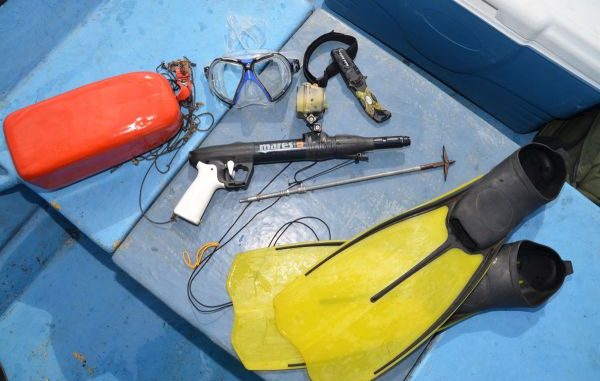
For all the “cool factor” in what Jacob Griffin does, his sport is decidedly low-tech.
His boat is simple 16-foot fiberglass skiff powered by a 40-horse outboard. No electronics are used.
The most expensive item in his toolbox is an optional one — the $300 GoPro submersible camera he attaches to his spear gun with black electrical tape.
The pneumatic spear gun he uses costs $250. His goggles cost $13. Swim fins, or flippers as he calls them, cost about $60. A diver’s knife will set him back another $70 or so.
Griffin ties a foam-filled homemade float to the butt of his spear gun with 12 feet of heavy, tarred nylon trotline twine, the same kind of twine he uses to attach the spear to the gun.
“When I shoot a big fish, 15 to 20 pounds and up, I let go of the gun to prevent the fish from being able to pull the spear out of its body against solid resistance. I hold the twine right behind the gun to keep it from sinking and tangling on the bottom while I swim with the fish until it tires,” Griffin explained. “A really big fish can pull the gun grip from your hand anyway.”
He said the use of a float is an area in which he differs from many other spearfishermen.
“Most of the people I dive with don’t use a buoy,” Griffin said. “They just hold on the gun, but if I lose a gun it’s $250 plus $300 for the camera.”
Another advantage to having a buoy, he pointed out, is that he can snap fish on the clips he has added to the end of the buoy and continue fishing instead of returning to the boat with every fish.
A $15 boat bumper from Academy Sporting Goods makes a good float, he offered for those who don’t want to make their own.
Griffin’s dive bag contains two other items: a wet suit and a spare set of swim fins.
The wet suit makes diving early in the season when the water is cool more comfortable. His preference is not to wear the suit unless necessary because of its added buoyancy.
The extra set of flippers is important. Sometimes the fins flip off a diver’s feet in all the commotion and can get lost in the murky silt stirred up from the bottom.
No fins means the end of the trip.
Griffin orders his gear online from Leisurepro.com or buys it in person from Underwater Adventures, which located on Government Street in Baton Rouge.
What is noticeably missing from Griffin’s gear are compressed air tanks — not even a snorkel.
“I don’t use tanks because they hang up,” he said. “Some of these stumps — you got to swim into them to find the fish.”
